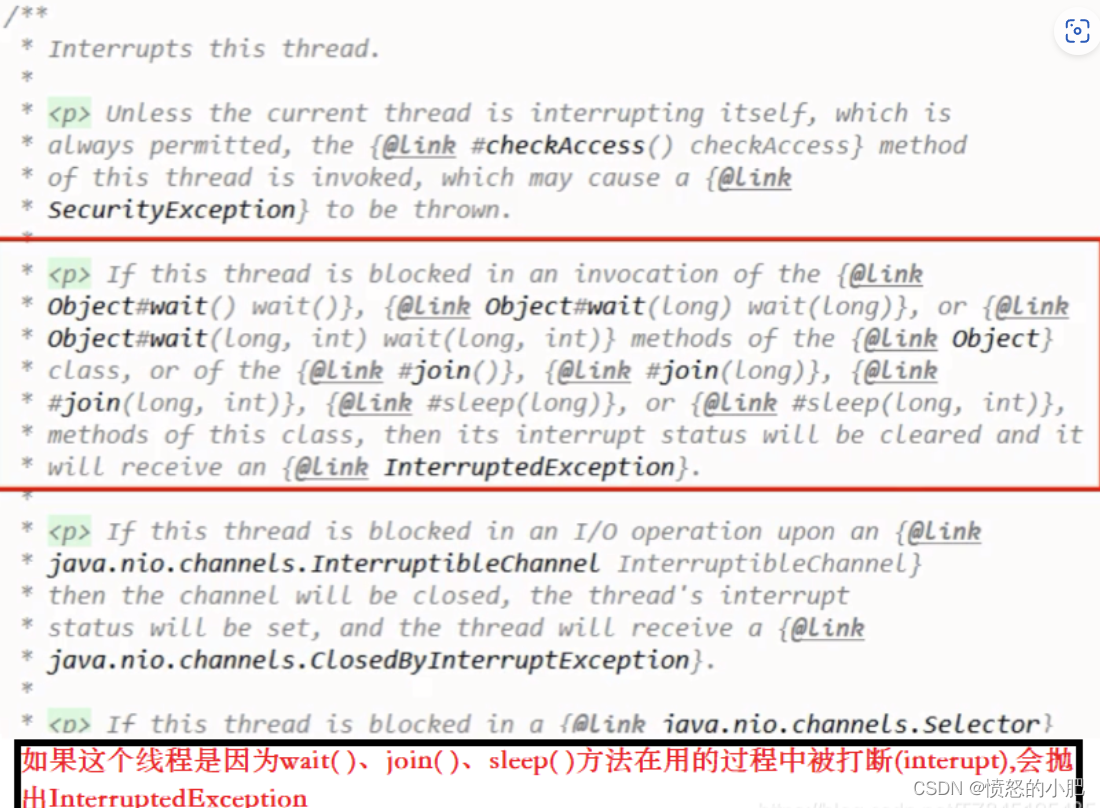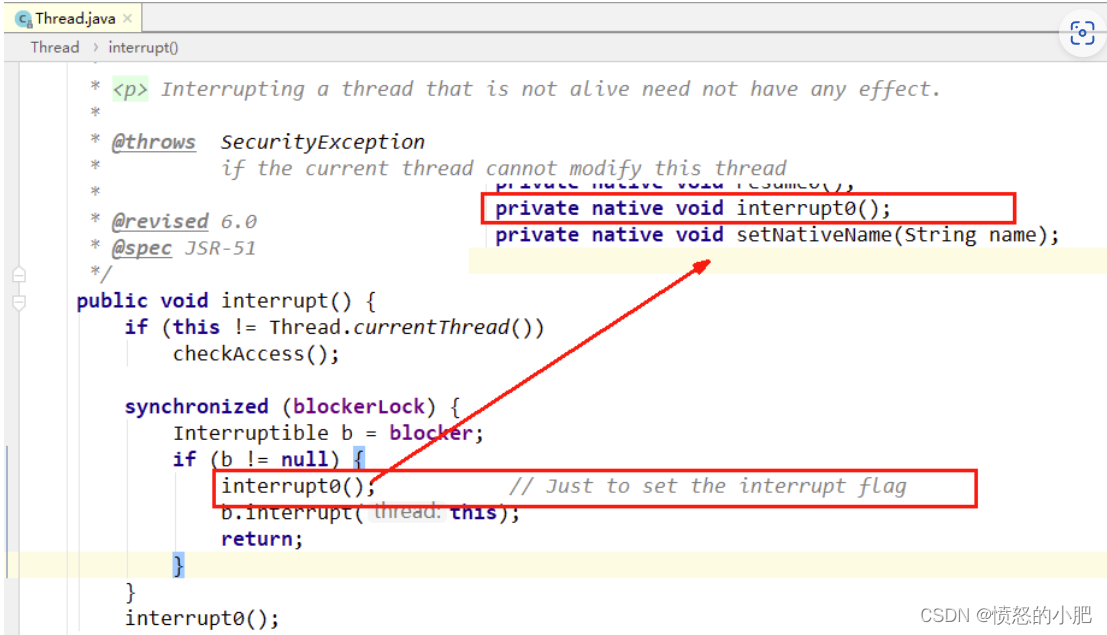①. void interrupt( )实例方法
interrupt( )仅仅是设置线程的中断状态未true,不会停止线程
源码解读
(如果这个线程因为wait()、join()、sleep()方法在用的过程中被打断(interupt),会抛出Interrupte dException)


②. boolean isInterrupted( )实例方法
判断当前线程是否被中断(通过检查中断标识位) 实例方法

③. static boolean interrupted( )静态方法
原理:假设有两个线程A、B,线程B调用了interrupt方法,这个时候我们连接调用两次isInterrupted方法,第一次会返回true,然后这个方法会将中断标识位设置位false,所以第二次调用将返回false

System.out.println(Thread.currentThread().getName()+"---"+Thread.interrupted());
System.out.println(Thread.currentThread().getName()+"---"+Thread.interrupted());
System.out.println("111111");
Thread.currentThread().interrupt();///----false---> true
System.out.println("222222");
System.out.println(Thread.currentThread().getName()+"---"+Thread.interrupted());
System.out.println(Thread.currentThread().getName()+"---"+Thread.interrupted());
/**
main---false
main---false
111111
222222
main---true
main---false
* */
复制④. 比较静态方法interrupted和实例方法isInterrupted
三种中断标识停止线程的方式
public class InterruptDemo{
static volatile boolean isStop = false;
static AtomicBoolean atomicBoolean = new AtomicBoolean(false);
public static void m3(){
Thread t1 = new Thread(() -> {
while (true) {
if (Thread.currentThread().isInterrupted()) {
System.out.println("-----isInterrupted() = true,程序结束。");
break;
}
System.out.println("------hello Interrupt");
}
}, "t1");
t1.start();
try { TimeUnit.SECONDS.sleep(1); } catch (InterruptedException e) { e.printStackTrace(); }
new Thread(() -> {
t1.interrupt();//修改t1线程的中断标志位为true
},"t2").start();
}
/**
* 通过AtomicBoolean
*/
public static void m2(){
new Thread(() -> {
while(true)
{
if(atomicBoolean.get())
{
System.out.println("-----atomicBoolean.get() = true,程序结束。");
break;
}
System.out.println("------hello atomicBoolean");
}
},"t1").start();
//暂停几秒钟线程
try { TimeUnit.SECONDS.sleep(1); } catch (InterruptedException e) { e.printStackTrace(); }
new Thread(() -> {
atomicBoolean.set(true);
},"t2").start();
}
/**
* 通过一个volatile变量实现
*/
public static void m1(){
new Thread(() -> {
while(true)
{
if(isStop)
{
System.out.println("-----isStop = true,程序结束。");
break;
}
System.out.println("------hello isStop");
}
},"t1").start();
//暂停几秒钟线程
try { TimeUnit.SECONDS.sleep(1); } catch (InterruptedException e) { e.printStackTrace(); }
new Thread(() -> {
isStop = true;
},"t2").start();
}
}
复制当前线程的中断标识为true,是不是就立刻停止?
public static void m5()
{
Thread t1 = new Thread(() -> {
while (true) {
if (Thread.currentThread().isInterrupted()) {
System.out.println("-----isInterrupted() = true,程序结束。");
break;
}
try {
Thread.sleep(500);
} catch (InterruptedException e) {
//线程的中断标志位重新设置为false,无法停下,需要再次掉interrupt()设置true
Thread.currentThread().interrupt();//???????
e.printStackTrace();
}
System.out.println("------hello Interrupt");
}
}, "t1");
t1.start();
try { TimeUnit.SECONDS.sleep(3); } catch (InterruptedException e) { e.printStackTrace(); }
new Thread(() -> {
t1.interrupt();//修改t1线程的中断标志位为true
},"t2").start();
}
/**
*中断为true后,并不是立刻stop程序
*/
public static void m4()
{
//中断为true后,并不是立刻stop程序
Thread t1 = new Thread(() -> {
for (int i = 1; i <= 300; i++) {
System.out.println("------i: " + i);
}
System.out.println("t1.interrupt()调用之后02: "+Thread.currentThread().isInterrupted());
}, "t1");
t1.start();
System.out.println("t1.interrupt()调用之前,t1线程的中断标识默认值: "+t1.isInterrupted());
try { TimeUnit.MILLISECONDS.sleep(3); } catch (InterruptedException e) { e.printStackTrace(); }
//实例方法interrupt()仅仅是设置线程的中断状态位设置为true,不会停止线程
t1.interrupt();
//活动状态,t1线程还在执行中
System.out.println("t1.interrupt()调用之后01: "+t1.isInterrupted());
try { TimeUnit.MILLISECONDS.sleep(3000); } catch (InterruptedException e) { e.printStackTrace(); }
//非活动状态,t1线程不在执行中,已经结束执行了。
System.out.println("t1.interrupt()调用之后03: "+t1.isInterrupted());
}
复制